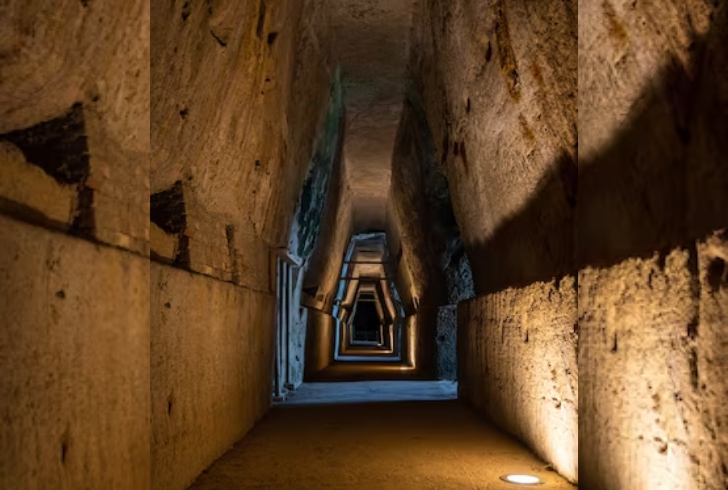For millennia, the colossal pyramids of Giza have captivated the hearts and minds of adventurers, scholars, and dreamers alike. These enigmatic structures, shrouded in the sands of time, stand as silent testaments to the ingenuity and ambition of an ancient civilization. Yet, beneath their sun-baked exteriors lies a labyrinth of hidden chambers, passageways, and secrets waiting to be unraveled.
Prepare to embark on a captivating exploration into the heart of these magnificent monuments, where we will delve into their history, unravel the mysteries they hold, and ponder the enduring legacy they leave behind.
A Glimpse Into the Bygone Era

Pixabay | henryleester |The story of the pyramids begins not in Giza but in a small town called Saqqara.
The story of the pyramids begins not in Giza but in a small town called Saqqara, located just north of present-day Cairo. It was here, around the 27th century BC, during the Old Kingdom of Egypt, that the first pyramid, the Step Pyramid of Djoser, emerged.
This groundbreaking structure, attributed to the legendary architect Imhotep, marked a radical shift from the traditional mastaba tombs used by earlier pharaohs. The Step Pyramid's unique tiered design, resembling a giant staircase, is believed to have served as a symbolic pathway for the pharaoh's soul to ascend to the heavens.
A Chronicle of Innovation
Following the groundbreaking innovation of the Step Pyramid, a wave of experimentation and refinement unfolded. Pharaoh Sneferu, Khufu's father, played a pivotal role in this process.
His relentless pursuit of architectural perfection is evident in the Meidum Pyramid and the Bent Pyramid, both located at Dahshur. While these attempts encountered structural challenges, they provided invaluable lessons that paved the way for the architectural masterpiece that would follow – the Great Pyramid of Giza.
The Great Pyramid

Freepik | superstarphoto | Great Pyramid of Giza, built by Pharaoh Khufu (Cheops) around 2570 BC.
Standing tall at a staggering 481 feet, the Great Pyramid of Giza, built by Pharaoh Khufu (Cheops) around 2570 BC, remains the largest pyramid ever constructed. Its sheer scale and intricate design leave visitors in awe, even today. Unlike its predecessors, the Great Pyramid boasts a smooth limestone casing, most of which has been lost over time. However, remnants of this once gleaming facade continue to hint at the pyramid's former grandeur.
One of the most intriguing aspects of the Great Pyramid is the layout of its internal chambers. Unlike other pyramids where the burial chambers are located below ground level, the Great Pyramid houses its most significant chambers, including the King's Chamber and the Queen's Chamber, within the pyramid structure itself. This unique layout has sparked numerous theories and continues to fuel debate among archaeologists and historians.
Beyond the Giza Plateau
The pyramids of Giza are not the only a testament to the enduring legacy of pyramid construction in Egypt. Similar structures, albeit smaller in size, can be found scattered across the country, each offering valuable insights into the evolution of this remarkable architectural style. Furthermore, the influence of pyramids extended beyond Egypt's borders, inspiring similar structures to be built by the Kushite kingdom in Nubia, south of Egypt.
Unveiling the Secrets

Freepik | EyeEm | Inside the Great Pyramid, visitors encounter a complex interior.
Despite the advancements made in archaeological research, the pyramids continue to hold onto their secrets. The purpose of the ventilation shafts, the true function of the Queen's Chamber, and the final resting place of Khufu's mummy remain unanswered questions. These enigmas continue to fuel exploration and research, reminding us that the quest for knowledge is a never-ending journey.
A Journey Through Time
As we stand before these magnificent structures, we are not merely observers of the past but participants in a timeless conversation. The pyramids serve as a bridge connecting us to the ancient Egyptians, their beliefs, and their aspirations. They remind us of the enduring power of human ingenuity and the enduring allure of the unknown.
The journey through the pyramids is not just an exploration of history; it is an invitation to ponder the vastness of time, the mysteries of the universe, and the enduring human spirit that continues to reach for the stars. So, the next time you gaze upon these awe-inspiring structures, remember that the pyramids are not merely tombs of stone, but portals to a bygone era, waiting to be explored.



